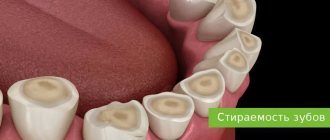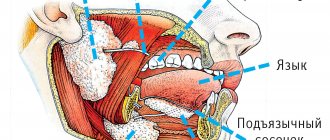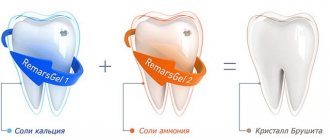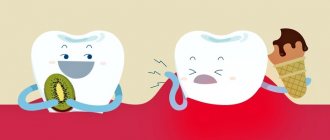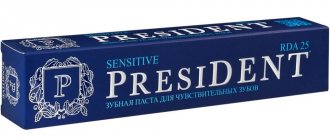Structure of tooth enamel
Tooth enamel is the main protector of teeth and completely covers their crown part. The average thickness of the tissue is about two millimeters: in the chewing area the layer is slightly thinner, and on the sides of the teeth, on the contrary, it is thicker. The color of tooth enamel depends on its density and the quality of dentin, as well as on some individual characteristics of the body, but this type of tissue is essentially transparent.
The composition of tooth enamel includes, for the most part, inorganic substances (more than 95%). The percentage of water content is very small (approximately 3%): this is partly why such high strength is achieved. Inorganic materials primarily refer to hydroxyapatite crystals (a mineral containing fluorine, magnesium, carbon and other elements). The presence of hydroxyapatite crystals also explains the fact that the enamel is vulnerable to the effects of an acidic environment, i.e. The consumption of foods that increase the acidity of saliva is contraindicated. This is especially true for calcium ions, on which the integrity and density of the enamel largely depends.
Main functions
The main functional task of this part of the tooth is the reliable protection of its internal structures - dentin and pulp. It is a barrier that prevents irritating mechanical, thermal and chemical effects on more sensitive and susceptible tissues. It is thanks to its hardness that we are able to bite and chew food freely and painlessly.
Generally speaking, teeth also help us reproduce sounds and, accordingly, speak. They are also responsible for the attractiveness of our smile and appearance in general, which ensures our comfort both psychologically and socially.
Enamel helps you bite and chew food
Types of damage to tooth enamel before teething
Dysplasia
A number of disorders, which is characterized by a number of signs: gray spots, thinning of the enamel or the absence of fragments of the enamel layer. In the vast majority of cases, dysplasia is associated with genetic abnormalities, metabolic disorders and bone diseases. When teething, teeth may be irregular in shape (triangular, pear-shaped, etc.).
To treat erosion of tooth enamel, multivitamins, sodium fluoride, and electrophoresis are prescribed. In case of extensive lesions, artistic restoration and prosthetics are used to restore aesthetics. To avoid complications, dental enamel dysplasia in children requires immediate treatment.
Hypoplasia
With hypoplasia, atrophy of tooth tissue or its complete absence is observed at the intrauterine level. Usually the disease is associated with a mineral imbalance. Hypoplasia is expressed by a change in color (to gray or brown), the appearance of spots, thinning of the enamel and even its complete absence (aplasia).
When treating thinning enamel, medications are prescribed to restore mineral balance (calcium gluconate solution, etc.), as well as a complex of vitamins. In case of aesthetic problems, whitening can be performed, and in severe cases, the tooth is covered with a crown or veneer.
Hyperplasia
Excess dental tissue, the appearance of which is also caused by an imbalance of mineral balance (usually due to hormonal imbalances in parents or blood diseases). On the surface of the tooth, so-called enamel drops are formed - islands of brown or reddish color. For more complex anomalies, hypertrophied areas can be filled with dentin or pulp.
Treatment of hyperplasia includes polishing teeth with a drill, applications and rinsing with fluoride and calcium solutions in combination with taking medications that normalize the mineral composition and eliminate the root cause of the deviation.
Fluorosis
When dental fluorosis occurs, spots, grooves, pits, or streaks form on the surface of the enamel. The disease is caused by an excess of fluoride in the body and often occurs in children.
Remineralization of enamel, grinding of teeth, and normalization of the amount of fluoride in the body are indicated. In difficult cases - orthopedic treatment and artistic restoration.
Changes in the structure and violation of the integrity of the enamel can be caused by a number of genetic abnormalities and hereditary diseases. That is why it is important to establish the root cause so that the best treatment can be prescribed if tooth enamel is damaged or atrophied.
Subtleties of selection and application
When choosing any paint and varnish product, you must carefully study the manufacturer’s recommendations written on the can and follow them. Thus, you should not use enamel intended for interior work when painting outside, as well as in the opposite case.
It is also necessary to pay attention to the paint container itself; there should be no damage to it, otherwise a broken seal of the can can lead to loss of properties of the product. In addition, the shelf life of the finishing material should not be expired, otherwise the enamel paint will lose its quality. Without fail, the container must have “GOST” on it, this will avoid counterfeiting.
Meanwhile, it is necessary to take into account the peculiarities of using paints and varnishes. As for enamels, despite the fact that there are a huge number of types combined into one group, each type has individual technical characteristics. Thus, nitrocellulose enamels are an ideal means for treating wooden bases, and alkyd paints are characterized by a wide range of uses, which includes not only outdoor work and indoor painting, but also decorative painting.
A smooth base without visible defects does not need putty before painting; you can limit yourself to cleaning and priming the surface. When working with enamel paint, it is permissible to use thinners and solvents of any type.
When working with enamel paint, it is permissible to use thinners and solvents of any type.
Damage to enamel after tooth formation
This section describes in detail the causes of diseases and destruction of tooth enamel that are not caused by genetic factors and congenital diseases at the stage of formation of tooth germs.
| Disease | Description | Prevention and treatment |
| Erosion | Non-carious damage to enamel and dentin, which can be caused by eating foods with high acidity, as well as diseases of the gastrointestinal tract, taking certain types of medications and using highly abrasive toothpastes or powders. | Therapy using calcium tablets or solution, mineralization of tooth enamel. |
| Sensitive tooth enamel | Acute reaction to cold and hot. Often associated with thinning of the enamel layer. Thin tooth enamel is also more vulnerable to caries bacteria. | Taking minerals and multivitamins to strengthen enamel. In some cases, orthodontic or orthopedic treatment is required. |
| Wedge-shaped defect | Exposure of the neck of the tooth and gradual destruction of the base. It is characterized by a change in color, a painful reaction to cold and hot in the affected area. | A wedge-shaped defect can be caused by both gum disease and problems with the thyroid gland and gastrointestinal tract. Depending on the cause, treatment is prescribed. The enamel is strengthened by taking medications, electrophoresis and installing fillings in the affected area. |
| Necrosis | Necrosis of tooth tissue begins with the appearance of light spots, which over time become brown or brown. In the vast majority of cases, necrosis is associated with metabolic disorders. | Elimination of the root cause coupled with therapeutic procedures. |
| Tooth enamel caries | First of all, caries affects tooth enamel. If treatment is not started in time, the disease will inevitably affect the deeper tissues of the tooth. | Treatment of the carious area and installation of a filling. In the early stages, today it is possible to treat caries without a drill, followed by restorative procedures for the enamel. |
| Mechanical injuries | Chips, bruises and dislocations of the tooth, as a result of which the integrity is disrupted and cracks form in the tooth enamel. | Therapeutic or orthopedic treatment depending on the type of injury. |
What is enamel paint?
Enamel paints are one of the types of paints and varnishes. Enamel is a paint that is used for both external and internal repair work. This type of paint is used for different surfaces, be it wood or metal or concrete.
The paint has increased moisture resistance and reliably protects the coating from any external influence. However, it is worth considering that this paint product is a fire hazard and toxic product.
The paint has increased moisture resistance and reliably protects the coating from any external influence.
Basic composition, what it contains
Despite the difference in characteristics between the subtypes of enamel, the main composition consists of five basic ingredients. The composition of the enamel is based on the following components:
- Varnish;
- Solvent;
- Coloring pigment;
- Filler;
- All kinds of additives.
The main composition consists of five basic ingredients.
How to strengthen tooth enamel?
The level of modern dentistry makes it possible to successfully eliminate tooth enamel defects through therapeutic and orthopedic techniques. In case of serious problems, it is necessary to use crowns, composite or ceramic veneers, but the best option is to preserve healthy and natural teeth. Today, many manufacturers offer various products that help avoid problems such as softening, erosion and thinning of tooth enamel.
Strengthening tooth enamel in adults
- Regular intake of vitamins B6 and B12, group D, as well as drugs that promote the absorption of calcium and fluoride.
- Therapeutic and prophylactic gels and toothpastes. Cleaning tooth enamel with non-abrasive products that contain calcium, fluoride and other components to strengthen the enamel.
- Mineralization of tooth enamel and regular preventive teeth cleaning. If you have naturally weak tooth enamel, these procedures are necessary to prevent the development of caries and other diseases. Tooth enamel whitening can be carried out only after consultation with your doctor, who will confirm the absence of contraindications.
- Prevention at home. Massage the gums, eat vegetables, fruits and legumes.
Remember that tooth enamel does not deteriorate in one day, but over many years, so the sooner you start caring for it, the longer you will maintain an attractive smile.
Strengthening tooth enamel in children
- Fluoridation. Application of special fluoride-containing varnishes to the surface of tooth enamel. After teething, the procedure is recommended to be carried out twice a year.
- The use of preventive mouth guards and application gels containing calcium, fluoride and vitamins.
- Fissure sealing to protect chewing teeth from caries.
Prevention and protection of tooth enamel in children will help to avoid serious problems in the future, so taking care of teeth should begin from the moment they erupt.
Personal hygiene basics
Of course, it is impossible to insure against dental diseases, but we can reduce the risk of their occurrence to the very minimum. To do this, it is enough to ensure proper oral hygiene, that is, regularly brush your teeth day and evening, use preventive rinses and flosses after each meal, try to eat healthy foods, including those rich in calcium and phosphorus, and also avoid smoking and excessive consumption sweets, flour, carbonated drinks and alcohol.
Proper oral hygiene will help keep your teeth healthy
It is also important not to forget to visit the dentist every six months for preventive examinations and removal of deposits. It is equally important to promptly treat any pathological changes in the cavity and not delay a visit to a specialist when the first suspicious symptoms appear.
PERIODONTAL
A major role in the aging of periodontal tissues is played by changes in blood vessels, collagen, enzyme activity, and immunobiological reactivity, when the processes of cell decay begin to prevail over the processes of their restoration. Metabolism slows down, oxygen supply to tissues decreases, and their dehydration increases. The composition of cellular elements changes and the level of lysozyme in the gum tissue decreases.
Therefore, the treatment of periodontal diseases always includes vitamin therapy, vascular and immunostimulating drugs, and all types of massage. It is absolutely necessary to strengthen the walls of blood vessels and strengthen the immune system constantly!
The most popular manufacturers, review
The most effective enamel paints are products from well-known manufacturers. Among the best companies are the Japanese manufacturer Tamiya, the Irish brand HUMBROL, the English brand Dulux, the German company Caparol, the Danish company Sadolin and the German-Polish joint venture Hansa.
The advantage of these brands is explained simply; they have many years of experience in the production of paints and varnishes. All of the listed manufacturers have products of the highest quality and an excellent reputation.
Russian manufacturers are also actively working to create the highest quality products. The following companies can please customers with their results:
- Belgorod enterprise "Painting paints";
- Yaroslavl production "SpetsEmal";
- St. Petersburg.
The most effective enamel paints are products from well-known manufacturers.
All paints and varnishes have individual technical characteristics. Therefore, in order to choose the most optimal option, you need to familiarize yourself with all the subtleties and nuances of enamels.
